| № |
Abstract |
| 1 |
M.A. Kinzhalov, G.L. Starova, V. P. Boyarskiy «Interaction of benzene-1,2-diamines with isocyanide complexes of palladium(II): Insight into the mechanism», Inorganica Chimica Acta, 2017,455, 607–612 DOI: 10.1016/j.ica.2016.05.014 |
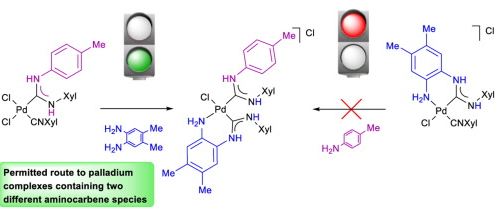 |
Abstract. Reactivity of 4-toluidine (2) and 4,5-dimethylbenzene-1,2-diamine (3) were compared in coupling with the palladium-bis(isocyanide) complex cis-[PdCl2(CNXyl)2] (Xyl = 2,6-Me2C6H3, 1), mixed isocyanide/diaminocarbene species cis-[PdCl2(CNXyl){C(NHXyl)NH(4-C6H4CH3)}] (4), and cis-[PdCl(CNXyl){C(NHXyl)NHC6H2(Me)2NH2}]Cl (5). In these Pd(II)-mediated reactions, 4,5-dimethylbenzene-1,2-diamine (3) was significantly more reactive than 4-toluidine (2), leading to the first mixed bis(diaminocarbene) complex cis-[PdCl{C(NHR)NHC6H2X2NH2}{C(NHXyl)NH(4-C6H4CH3)}]Cl (6) containing two different diaminocarbene ligands. Complex 6 was isolated and characterized by elemental analyses (C, H, N), HRESI+-MS, IR, 1H and 13C{1H} NMR spectroscopies, and single-crystal X-ray diffraction. |
| 2 |
A.S. Koneva, E.A. Safonova, P.S. Kondrakhina, M.A. Vovk, A.A. Lezov, Yu. S. Chernyshev, N.A. Smirnova «Effect of Water Content on Structural and Phase Behavior of Water-in-Oil (n-Decane) Microemulsion System Stabilized by Mixed Nonionic Surfactants SPAN80/TWEEN80», Colloids and Surfaces A: Physicochemical and Engineering Aspects, 2017,518, 273-282 DOI: 10.1016/j.colsurfa.2017.01.020 |
 |
Abstract. For the search of effective microemulsion systems with the properties demanded for various applications the knowledge of structural properties of the reverse microemulsions for various compositions and temperatures is of high value. In the present study, the microstructure and diffusion of the components of water-in-n-decane Winsor IV microemulsions stabilized by a mixture of nonionic surfactants Span 80 (sorbitane monooleate, HLB 4.9) and Tween 80 (polyoxyethylene sorbitan monooleate, HLB 15.0) at the weight ratios 49:51 (i.e. at the maximal ability to solubilize water) were investigated by viscosimetry, PGSTE NMR and DLS. The system phase diagram obtained at 298.2 K includes the intermediate heterogeneous region between the reverse micelles region and the microemulsions. The water-to-surfactant molar ratio was changed up to 15.5 (13 wt.% of water) at the weight ratios n-decane: surfactants 65:35 and 85:15. The microemulsion droplets are spherical (that is corresponded also to the cryo-TEM data) and grow with the increase of water content. The temperature effect on the aggregates diffusion (and on the aggregates size) in the range 298.2–318.2 K is not pronounced. The bimodal distributions of the diffusion coefficients determined using both DLS and PGSTE NMR methods are specific for the system. The slower diffusion mode relates to the diffusion of mixed microemulsion droplets with the radii Rh ∼10–20 nm. The second stable form of nanoaggregates are “dry” micelles with Rh ∼ 1–2 nm. The data on the diffusion coefficients are of special interest in particular for the molecular dynamic simulation of the reverse micelles or of the microemulsion droplets |
| 3 |
E. V. Andrusenko, E. V. Kabin, A. S. Novikov, N. A. Bokach, G. L. Starova, V. Yu. Kukushkin «Metal-Mediated Generation of Triazapentadienate-terminated Di- and Trinuclear μ2-Pyrazolate NiII Species and Control of their Nuclearity», New Journal of Chemistry, 2017,41, 316-325 DOI: 10.1039/C6NJ02962K |
 |
Abstract. 1,3,5-Triazapentadienate-terminated di- and trinuclear nickel(II) complexes featuring bridging azolate ligands, [Ni2(μ2-azolate)2(TAP)2] (TAP = H[N with combining low line][double bond, length as m-dash]C(OMe)NC(OMe)[double bond, length as m-dash][N with combining low line]H; azole = 3,5-Me2pyrazole 2, 3,5-Ph2pyrazole 3) and [Ni3(μ2-azolate)4(TAP)2] (azole = 3,5-Me2pyrazole 4, indazole 5), were obtained from systems Ni2+/NCNR2/azole systems in MeOH. The terminal TAP ligands in the [Ni2(μ2-azolate)2(TAP)2] and [Ni3(μ2-azolate)4(TAP)2] species originate from the previously unreported cascade NiII-mediated and chelation-driven reaction between cyanamides and methanol. The oligomeric species and also [Ni(TAP)2] (1) are subject to interconversions that depend on the reactants involved and the reaction conditions. The control of the nuclearity of the complexes can be achieved by changing the amount of azoles or by their protonation, alteration of the steric hindrance of the substituents in the heterocycles, and by changing the reaction temperature. Complexes 1–4 were characterized using elemental (C, H, N) analyses, 1H, 13C{1H} NMR, FTIR, HRESI-MS, TG-DTA, X-ray crystallography, and 5 was characterized using HRESI-MS and X-ray crystallography. Unconventional metallophilic contacts NiII⋯NiII were observed in dimer 3 in the solid state (the distance for Ni⋯Ni is 2.99 Å, whereas the double Bondi’s vdW radius for Ni is 3.26 Å) and the reality of these interactions was confirmed theoretically by the topological analysis of the electron density distribution (AIM method). The estimated energy for these non-covalent Ni⋯Ni interactions (ca. 4 kcal mol−1) fills the gap in the reported energies of the metal⋯metal interactions in a series comprising of NiII⋯NiII (this work), PdII⋯PdII (4.3–6.0 kcal mol−1), and PtII⋯PtII (3.9–11.7 kcal mol−1). |
| 4 |
Е. А. Чалая, А. Г. Тюрин, М. В. Васеха, А. И. Бирюков, С. М. Сухаржевский «СИНТЕЗ И СВОЙСТВА ДВОЙНОГО СУЛЬФИТА МЕДИ(I) – КОБАЛЬТА(II)», НЕОРГАНИЧЕСКИЕ МАТЕРИАЛЫ, 2017,53 (9), 1–9 |
| |
Abstract. Уточнены диаграммы Пурбе систем Сu–Н2SO4–H2O и Co–H2SO4–H2O, в них определены области устойчивости сульфитных фаз. Построены диаграммы состояния двойных сульфитов меди(I)-меди(II), меди(I)-кобальта(II). Из водного раствора, насыщенного диоксидом серы, выделены двойные сульфиты: Cu2SO3 · СuSO3, Cu2SO3 · CoSO3. Получены спектры электронного парамагнитного резонанса, выполнены рентгенофазовый, ИК-спектроскопический,
дисперсионный и термический анализы выделенного двойного сульфита CoSO3 · Cu2SO3. Заложена основа термодинамического прогнозирования синтеза двойных сульфитов состава Cu2SO3 · MSO3 (М – Cu, Co). |
| 5 |
E.A. Katlenok, S.N. Smirnov, A.Yu. Ivanov, S.V. Makarenko, K.P. Balashev «Effect of the Donor–Acceptor Properties of Ligands on the Spectroscopic and Electrochemical Properties of Mixed-Ligand Complexes of Pt(II) and Ir(III) with Cyclometalated 2-Phenylbenzothiazole», Optics and Spectroscopy, 2017, 122, 723-728 DOI: 10.1134/S0030400X17030110 |
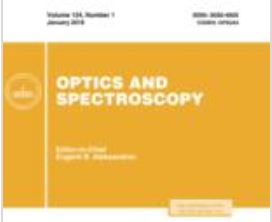 |
Abstract. The results of the spectroscopic NMR (1H, 13C, and 195Pt), infrared, optical, and voltammetric characteristics of the mixed-ligand complexes of Pt(II) and Ir(III) with metalated 2-phenylbenzothiazole and tert-butylisocyanide (tBuNC), acetonitrile (AN), ethylenediamine (En), O-ethyldithiocarbamate (Exn–), and diethyldithiocarbamate (Dtc–) ions are presented. It is demonstrated that the change in donor–acceptor interaction of ligands tBuNC, AN, En, Exn–, and Dtc– with metal leads to an increase in the energy of the highest occupied molecular orbital of the complexes and is accompanied by a shift of the cathode potential of the metal-centered oxidation, a bathochromic shift of the spin-allowed and spin-forbidden metal-tocyclometalated ligand optical charge transfer transitions, and an increase the degree of mixing of the 1MLCT and triplet intraligand states, responsible for the phosphorescence of the complexes. |
| 6 |
Anastasiia M. Afanasenko, Dina V. Boyarskaya, Irina A. Boyarskaya, Tatiana G. Chulkova, Yakov M. Grigoriev, Ilya E. Kolesnikov, Margarita S. Avdontceva, Taras L. Panikorovskii, Andrej I. Panin, Anatoly N. Vereshchagin, Michail N. Elinson «Structures and photophysical properties of 3,4-diaryl-1H-pyrrol-2,5- diimines and 2,3-diarylmaleimides», Journal of Molecular Structure, 2017,1148, 554-561 DOI: 10.1016/j.molstruc.2017.06.048 |
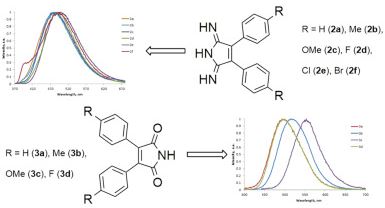 |
Abstract. Structural features of 3,4-diaryl-1H-pyrrol-2,5-diimines and their derivatives have been studied by molecular spectroscopy techniques, single-crystal X-ray diffraction, and DFT calculations. According to the theoretical calculations, the diimino tautomeric form of 3,4-diaryl-1H-pyrrol-2,5-diimines is more stable in solution than the imino-enamino form. We also found that the structurally related 2,3-diarylmaleimides exist in the solid state in the dimeric diketo form. 3,4-Diaryl-1H-pyrrol-2,5-diimines and 2,3-diarylmaleimides exhibit fluorescence in the blue region of the visible spectrum. The fluorescence spectra have large Stokes shifts. Aryl substituents at the 3,4-positions of 1H-pyrrol-2,5-diimine do not significantly affect fluorescence properties. The insertion of donor substituents into 2,3-diarylmaleimides leads to bathochromic shift of emission bands with hyperchromic effect. |
| 7 |
Anastasiia M. Anastasia I. Solomatina, Irina O. Aleksandrova, Antti J. Karttunen, Sergey P. Tunik, Igor O. Koshevoy «Dibenzothiophene-platinated complexes: probing the effect of ancillary ligands on the photophysical performance», Dalton Transactions, 2017 DOI: 10.1039/C7DT00349H |
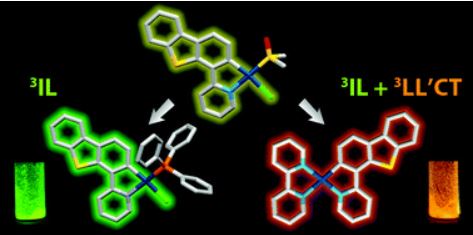 |
Abstract. Cyclometalation of dibenzothienyl-pyridine (HPyDBT) afforded a series of platinum(II) complexes Pt(PyDBT)(L)Cl (L = DMSO, 1; P(p-C6H4-X)3 (X = H, 2; CF3, 3; OMe, 4; NPh2, 5); 1,3,5-triaza-7-phosphaadamantane, 6; 2,6-dimethylphenyl isocyanide, 7). Chelating bidentate LL ligands formed cationic compounds [Pt(PyDBT)(LL)]+ (LL = 1,2-bis(diphenylphosphino)benzene, 8; 2,2′-bipyridine, 9; 1,10-phenanthroline, 10). Oxidation of a thienyl sulfur atom allowed for the isolation of the sulfone derivative Pt(PyDBT)(PPh3)Cl (11). The title complexes were characterized crystallographically (except 7). Investigation of their photophysical behavior revealed solid state phosphorescence with quantum yields up to 0.45 for neat powders. The ancillary ligands L show a minor influence on the emission energies of the neutral compounds, but affect dramatically the intensity of luminescence. In contrast, the cationic species with diimine ligands demonstrate a significant contribution of the LL fragments into the emissive T1 states that leads to a certain mixing of 3IL and 3LL′CT transitions and causes a substantial bathochromic shift of emission. |
| 8 |
J.R. Shakirova, E.V. Grachova, V.V. Sizov, G.L. Starova, I.O. Koshevoy, A.S. Melnikov, M.C. Gimeno, A. Laguna, and S.P. Tunik «Polynuclear cage-like Au(I) phosphane complexes based on S2− template: observation of multiple luminescence in coordinated polyaromatic systems», Dalton Transactions, 2017, 46, 2516-2523 DOI: 10.1039/C6DT04126D |
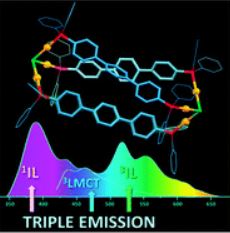 |
Abstract. A rational approach to the synthesis of cage-like compounds has been realized to build a new family of sulfido-phosphane Au(I) polynuclear complexes. Ditopic phosphane ligands with an extended aromatic system were used to obtain cage compounds with a clearly determined geometry. Au(I) complexes have been fully characterised in solution using spectroscopy methods, and DFT optimisation of the molecular structure gives additional arguments in favour of the suggested structural patterns. All complexes obtained are luminescent in solution and in the solid state, and display multiple emissions with an unusual combination of two phosphorescence bands and one fluorescence band. DFT calculations show that multiple emissions were mainly determined by 1IL and metal perturbed 3IL transitions. The ratio of singlet and triplet emission components depends on the distance between the ligand chromophoric centre and Au(I). |
| 9 |
E.G. Vlakh, E.V. Grachova, D.D. Zhukovsky, A.V. Hubina, J.R. Shakirova, A.S. Mikhailova, V.V. Sharoyko, S.P. Tunik, T.B. Tennikova «Self-аssemble nanoparticles bаsed on polypeptides containing C-terminal luminescent Pt-cysteine complex», Scientific Reports, 2017,7, 41991 DOI: 10.1038/srep41991 |
| |
Abstract. The growing attention to the luminescent nanocarriers is strongly stimulated by their potential application as drug delivery systems and by the necessity to monitor their distribution in cells and tissues. In this communication we report on the synthesis of amphiphilic polypeptides bearing C-terminal phosphorescent label together with preparation of nanoparticles using the polypeptides obtained. The approach suggested is based on a unique and highly technological process where the new phosphorescent Pt-cysteine complex serves as initiator of the ring-opening polymerization of α-amino acid N-carboxyanhydrides to obtain the polypeptides bearing intact the platinum chromophore covalently bound to the polymer chain. It was established that the luminescent label retains unchanged its emission characteristics not only in the polypeptides but also in more complicated nanoaggregates such as the polymer derived amphiphilic block-copolymers and self-assembled nanoparticles. The phosphorescent nanoparticles display no cytotoxicity and hemolytic activity in the tested range of concentrations and easily internalize into living cells that makes possible in vivo cell visualization, including prospective application in time resolved imaging and drug delivery monitoring. |
| 10 |
A. Filatov, N. Knyazev, A. Molchanov, T. Panikorovsky, R. Kostikov, A. Larina, V. Boitsov, A. Stepakov «Synthesis of functionalized 3-spiro[cyclopropa[a]pyrrolizine]- and 3-spiro[3-azabicyclo[3.1.0]hexane]oxindoles frоm cyclopropenes and azomethine ylides via [3+2]-cycloaddition», The Journal of Organic Chemistry, 2017,82, 959-975 DOI: 10.1021/acs.joc.6b02505 |
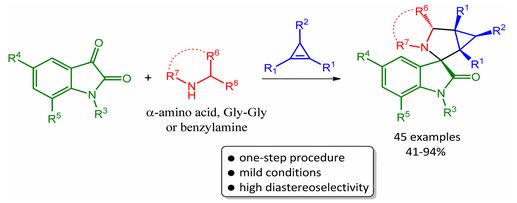 |
Abstract. 3-Spiro[cyclopropa[a]pyrrolizine]- and 3-spiro[3-azabicyclo[3.1.0]hexane]oxindoles were prepared in moderate to high yields via one-pot three-component reactions using substituted isatins, α-amino acids, and cyclopropenes. The key step is an intramolecular [3 + 2]-cycloaddition reaction of an in situ generated azomethine ylide onto a cyclopropene. Both N-substituted and N-unsubstituted α-amino acids, dipeptide Gly-Gly, and also benzylamine were used as the amine component for the azomethine ylide generation. The anticancer activity of some of the obtained compounds against human leukemia K562 cell line was evaluated by flow cytometry in vitro. |
| 11 |
A. Larina, A. Filatov, V. Suslonov, A. Molchanov, A. Stepakov «The reactions of 1,1-diarylallenes with N-acyliminium cations generated frоm hydroxylactams», Tetrahedron, 2017,73, 3949-3958 DOI: 10.1016/j.tet.2017.05.071 |
 |
Abstract. he first example of the reactions of 1,1-diarylallenes with N-acyliminium cations is described. 2-Aryl-3-(3-aryl-1H-inden-2-yl)isoindolin-1-ones and 6-methylene-5,5-diaryl-6,6a-dihydroisoindolo[2,1-a]quinolin-11(5H)-ones were prepared by BF3·OEt2-mediated reactions of 1,1-diarylallenes with the N-acyliminium cations generated from 2-aryl-3-hydroxyisoindolin-1-ones. 2-Aryl-3-(3-aryl-1H-inden-2-yl)isoindolin-1-ones underwent an intramolecular cyclization on treatment with methanesulfonic acid with the formation of compounds exhibiting the indeno[2,1-c]isoindolo[2,1-a]quinoline skeleton. |
| 12 |
Sergey Miltsov, Vladimir Karavan, Alexandr Misharev, Galina Starova, Julian Alonso-Chamarro, Mar Puyol «Unprecedented acid-catalyzed Wurtz-type coupling of meso-bromoindodicarbocyanine dyes», Tetrahedron Letters, 2017,58, 3353–3357 DOI: 10.1016/j.tetlet.2017.07.043 |
 |
Abstract. meso-Bromosubstituted indodicarbocyanine dyes produce dimeric molecules, together with the debrominated species, under acid catalysis. The relationship between the dimerization and hydrodebromination routes depends on the aryl substitution of the dyes. A possible reaction mechanism is also proposed |
| 13 |
M.V. Il’in a, D.S. Bolotin, A.S. Novikov, V.V. Suslonov, N.V. Chezhina, M.P. Bubnov, V.K. Cherkasov, G. J.S. Venter, A. Roodt «Square-planar aminonitronate transition metal complexes (M = CuII, NiII, PdII, and PtII)» , Inorganica Chimica Acta, 2017,467, 372–378 DOI: 10.1016/j.ica.2017.08.034 |
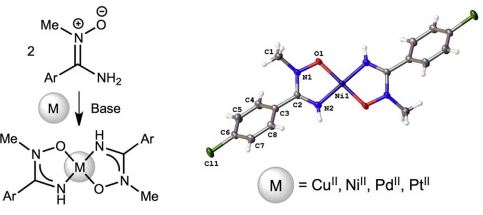 |
Abstract. Treatment of the aromatic aminonitrones p-RC6H4C(NH2)N+(Me)O− (R = NMe2, Cl) with CuCl2·2H2O, NiCl2·2H2O, β-PdCl2, or cis-[PtCl2(Me2SO)2] in the presence of a base leads to the [M{p-RC6H4C(NH)N+(Me)O−}2] (M = Cu, Ni, Pd) (72–95%) or [Pt{p-RC6H4C(NH)N+(Me)O–}Cl(Me2SO)] (ca. 80%) complexes, respectively. These compounds were characterized by elemental analyses (C, H, N), HRESI+-MS, FTIR, 1H and 13C{1H} NMR, and for the CuII and NiII complexes EPR and magnetic susceptibility. In addition, eight species were studied by single-crystal X-ray diffraction. In the X-ray structures of 2a–d, the hydrogen bonds are responsible for the formation of 1D polymeric chains. These bonds were evaluated by DFT calculations (M06/DZP-DKH level of theory) and topological analysis of the electron density distribution within the formalism of Bader’s theory (QTAIM method). Estimated strengths of these non-covalent interactions are 2.7–4.4 kcal/mol. |
| 14 |
Dmitrii S. Bolotin, Mikhail V. Il’in, Alexander S. Novikov, Nadezhda A. Bokach, Vitalii V. Suslonov and Vadim Yu. Kukushkin «Trinuclear (aminonitrone)ZnII complexes as key intermediates in zinc(II)-mediated generation of 1,2,4-oxadiazoles frоm amidoximes and nitriles» , New Journal of Chemistry, 2017,41, 1940–1952 DOI: 10.1039/c6nj03508f |
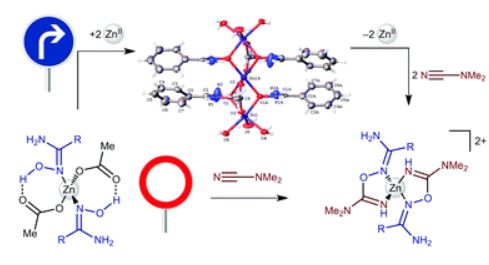 |
Abstract. Aliphatic and aromatic amidoximes RC(NH2)[double bond, length as m-dash]NOH (R = Et, tBu, Ph, o-ClC6H4) react with Zn(OAc)2·2H2O in Me2CO giving [Zn(OAc)2{RC(NH2)[double bond, length as m-dash]NOH}2] complexes bearing N-bound amidoximes, which are involved in a moderate strength (7.3–11.9 kcal mol−1 by the DFT calculations) intramolecular resonance-assisted hydrogen bonding between the oxime HO group and the oxo group of the acetate ligand. The complexes [Zn(OAc)2{RC(NH2)[double bond, length as m-dash]NOH}2] react with excess Zn(OTf)2 in acetone accomplishing trinuclear species [Zn3(μ2-OAc)2{μ2-RC(NH2)[double bond, length as m-dash]N(H)O}4(H2O)6](OTf)4 featuring both O-ligated amidoximes—stabilized in the aminonitrone tautomeric form—and bridging acetate ligands. The aminonitrone trinuclear species were also prepared directly via the reaction of the amidoximes with Zn(OTf)2 in EtOAc; ethyl acetate in this reaction plays the role of the acetate donor and OAc− is generated in situ via ZnII-mediated hydrolysis of EtOAc. Although [Zn(OAc)2{RC(NH2)[double bond, length as m-dash]NOH}2] are inactive toward dimethylcyanamide, the [Zn3(μ2-OAc)2{μ2-RC(NH2)[double bond, length as m-dash]N(H)O}4(H2O)6](OTf)4 complexes readily react with Me2NCN giving, as a result of ZnII-mediated amidoxime–cyanamide coupling, the O-carbamidine amidoxime complexes [Zn(OTf)2{RC(NH2)[double bond, length as m-dash]NOC(NMe2)[double bond, length as m-dash]NH}2]. All synthesized compounds were characterized by HRESI-MS, FTIR, 1H-, CP-MAS TOSS 13C{1H}-, and 13C{1H} NMR, and additionally by single-crystal X-ray diffraction for eight species. Different types of non-covalent interactions in the obtained solid-state structures were studied by DFT calculations (M06-2X/6-311+G(d,p) level of theory) and topological analysis of the electron density distribution within the formalism of Bader’s theory (QTAIM method). |
| 15 |
Dmitrii S. Bolotin, Marina Ya. Demakova, Anton A. Legin, Vitaliy V. Suslonov, Alexey A. Nazarov, Michael A. Jakupec, Bernhard K. Kepplerb and Vadim Yu. Kukushkin «Amidoxime platinum(II) complexes: pH-dependent highly sеlеctive generation and cytotoxic activity», New Journal of Chemistry, 2017,41, 6840–6848 DOI: 10.1039/c7nj00982h |
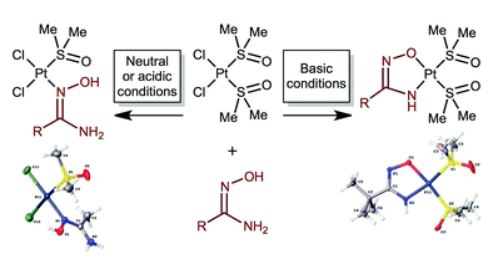 |
Abstract. The reaction of cis-[PtCl2(Me2[S with combining low line]O)2] with 1 equiv. of each of the amidoximes RC(NH2)[double bond, length as m-dash]NOH in neutral media in MeOH results in the formation of complexes cis-[PtCl2{RC(NH2)[double bond, length as m-dash][N with combining low line]OH}(Me2[S with combining low line]O)] (5 examples; 83–98% isolated yields). In the presence of 2 equiv. of NaOH in MeOH solution, the reaction of cis-[PtCl2(Me2[S with combining low line]O)2] with 1 equiv. of each of the amidoximes RC(NH2)[double bond, length as m-dash]NOH leads to [Pt{RC([N with combining low line]H)[double bond, length as m-dash]N[O with combining low line]}(Me2[S with combining low line]O)2] (7 examples; 74–95% isolated yields). All new complexes were characterized by C, H, and N elemental analyses, HRESI+-MS, IR, 1H, 13C{1H}, and CP-MAS TOSS 13C{1H} NMR spectroscopies, and additionally by single-crystal XRD (for seven species). The cytotoxic potency of six compounds was determined in the human cancer cell lines CH1/PA-1, A549, SK-BR-3, and SW480. Generally, the second class of complexes containing chelating amidoximato ligands shows much higher cytotoxicity than the non-chelate amidoxime analogs, despite the lack of easily exchangeable chlorido ligands. Especially, the complex [Pt(p-CF3C6H4C([N with combining low line]H)[double bond, length as m-dash]N[O with combining low line])(Me2[S with combining low line]O)2] displays a remarkable activity in the inherently cisplatin resistant SW480 cell line (0.51 μM vs. 3.3 μM). |
| 16 |
Sevastyan Rabdano, Ivan Podkorytov, Dmitrii Luzik, Nikolai Skrynnikov «сhаracterizing the size of protein aggregate particles using a combination of NMR diffusion measurements and dynamic light scattering: case study of RRM2 domain frоm protein TDP-43», The FEBS Journal, 2017,284, 212 DOI: 10.1111/febs.14174 |
| |
|
| 17 |
K. S. Rodygin, Y. V. Gyrdymova, V. V. Zarubaev «Synthesis of vinyl thioethers and bis-thioethenes frоm calcium carbide and disulfides», Mendeleev Communications, 2017, 476–478 DOI: 10.1016/j.mencom.2017.09.015 |
 |
Abstract. Bis-thioethenes and vinyl thioethers were obtained from the reaction of disulfides and calcium carbide in good to high yields using a simple synthetic procedure and common laboratory setup. The tolerance of the reaction was investigated by the examples of aliphatic, aromatic, heteroaromatic and sesquiterpenic substrates. |
| 18 |
Roman Vasilevich, Evgeny Lodygin, Vasily Beznosikov, Evgeny Abakumov «Molecular composition of raw peat and humic substances frоm permafrost peat soils of European Northeast Russia as climate change markers», Science of the Total Environment, 2017,615, 1229-1228 DOI: 10.1016/j.scitotenv.2017.10.053 |
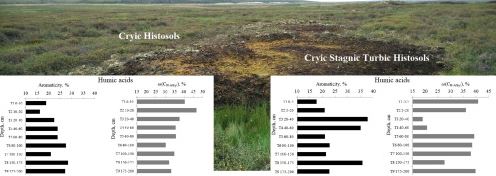 |
Abstract. Humic substances (HSs) from the mire peat soils of the forest-tundra zone of the European northeast part of Russia have been characterized in terms of molecular composition. This was accomplished using solid-state 13C nuclear magnetic resonance (13C NMR) techniques and electron spin resonance (ESR) spectroscopy. The composition depended on the intensity of cryogenic processes in the active layer, the quality of the humification precursors (the degree of peat material transformation), and the biochemical selection of aromatic fragments during humification. Humic acids (HAs) and fulvic acids (FAs) of the peat soils showed the presence of compounds with a low extent of condensation and a low portion of aromatic fragments, which increased with depth. A higher proportion of aliphatic carbon species was found in the HAs, indicating a low degree of organic matter stabilization. Based on the data from the two types of peat soils, we suggest that particular changes in the proportion of aromatic and unoxidized aliphatic fragments on the border of the bottom of the active layer and permafrost layers can be used as markers of current climatic change. |
| 19 |
E. Abakumov «сhаracterisation of humic acids, isolated frоm sеlеcted subantarctic soils by 13C-NMR spectroscopy», CZECH POLAR REPORTS, 2017,7(1), 1-10 DOI: 10.5817/CPR2017-1-1 |
| |
Abstract. Soils of Antarctic considered as underestimated in terms of soils organic matter polls, organic remnants humification/mineralization rates and biogenic-abiogenic interactions. Humic acids of selected Sub Antarctic soils were investigated in terms of elemental and structural composition with special reference to evaluation of organic matter stabilisation degree and assessment of carbon species distributions in the molecules with use of solid state 13C-NMR spectroscopy. It was shown, that the prevailing of aliphatic compounds on the aromatic one is more pronounced in Antarctic soils than in Arctic ones. Average portion of the aromatic compounds is about 20% in humic acids, extracted from soils with evident ornitogenic effect from Fildes Peninsula (Norh-West Antarctic peninsula). This indicates that the role of humification precursors composition is the leading in the humification process. The stabilisation rate of the Antarctic HAs can be assessed as low and the potential risk of biodegradation of their molecules are high. |
| 20 |
Konstantin V. Luzyanin, Aleksei N. Marianov, Pavel G. Kislitsyn, and Valentine P. Ananikov «Substrate-sеlеctive C−H Functionalization for the Preparation of Organosulfur Compounds frоm Crude Oil-Derived Components», ACS Omega, 2017,2, 1419-1423 DOI: 10.1021/acsomega.7b00137 |
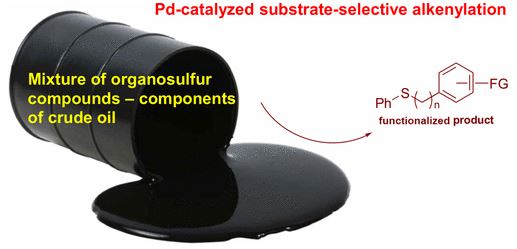 |
Abstract. The direct utilization of a natural feedstock in organic synthesis is an utmost challenge because the selective production of one product from a mixture of starting materials requires unprecedented substrate selectivity. In the present study, a simple and convenient procedure is evaluated for the substrate-selective alkenylation of a single component in a mixture of organosulfur compounds. Pd-catalyzed alkenylation of two-, three-, four-, and five-component mixtures of crude oil-derived sulfur species led to the exclusive C–H functionalization of only one compound. The observed remarkable substrate selectivity opens new opportunities for sustainable organic synthesis. |
| 21 |
Georg Werner, Konstantin S. Rodygin, Anton A. Kostin, Evgeniy G. Gordeev, Alexey S. Kashin and Valentine P. Ananikov «A solid acetylene reagent with enhanced reactivity: fluoride-mediated functionalization of alcohols and phenols», Green Chemistry, 2017,19, 3032-3041 DOI: 10.1039/c7gc00724h |
 |
Abstract. The direct vinylation of an OH group in alcohols and phenols was carried out utilizing a novel CaC2/KF solid acetylene reagent in a simple K2CO3/KOH/DMSO system. The functionalization of a series of hydroxyl-group-containing substrates and the post-modification of biologically active molecules were successfully performed using standard laboratory equipment, providing straightforward access to the corresponding vinyl ethers. The overall process developed involves an atom-economical addition reaction employing only inorganic reagents, which significantly simplifies the reaction set-up and the isolation of products. A mechanistic study revealed a dual role of the F− additive, which both mediates the surface etching/renewal of the calcium carbide particles and activates the C[triple bond, length as m-dash]C bond towards the addition reaction. The development of the fluoride-mediated nucleophilic addition of alcohols eliminates the need for strong bases and may substantially extend the areas of application of this attractive synthetic methodology due to increasing functional group tolerance. As a replacement for dangerous and difficult to handle high-pressure acetylene, we propose the solid reagent CaC2/KF, which is easy to handle, does not require dedicated laboratory equipment and demonstrates enhanced reactivity of the acetylenic triple bond. Theoretical calculations have shown that fluoride-mediated activation of the hydroxyl group towards nucleophilic addition significantly reduces the activation barrier and facilitates the reaction. |
| 22 |
Konstantin S. Rodygin, Irina Werner, Valentine P. Ananikov «Green and sustainable route to carbohydrate vinyl ethers for accessing bio-inspired materials with a unique microspherical morphology»,ChemSusChem, 2017DOI: 10.1002/cssc.201701489 |
| |
Abstract. Synthesizing chemicals and materials from renewable sources is one of the main aims of modern science. Carbohydrates represent excellent renewable natural raw materials that are ecofriendly, inexpensive, and biologically compatible. A green procedure has been developed for the vinylation of carbohydrates by using readily available calcium carbide. Various carbohydrates were utilized as starting materials, resulting in mono-, di-, and tetravinyl ethers in high to excellent yields (81–92 %). The synthesized biobased vinyl ethers were utilized as monomers in free radical and cationic polymerizations. A unique combination of a smooth surface and intrinsic microcompartments was achieved in the synthesized materials. Two types of biobased materials were prepared involving microspheres and intrinsic hollow compartments in polymers. Scanning electron microscopy with built-in ion beam cutting was applied to reveal the spatial hierarchical structures in 3D space. |
| 23 |
Yu.A. Kondratenko, G.G. Nyanikova, K.V. Molchanova, T.A. Kochina «сhаracteristics of Protic Ionic Liquids Based on Triethanolammonium Salts of Biologically Active Carboxylic Acids and Their Impact on the Growth Properties of the Rhizopus oryzae Fungus», Glass Physics and Chemistry, 2017,43, 445–451 DOI: 10.1134/S108765961705008X |
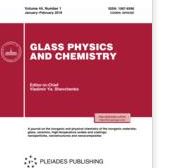 |
Abstract. A series of protic alkanolammonium ionic liquids (ILs) based on triethanolammonium salts (protatranes) of biologically active carboxylic acids (cinnamic, benzoic, oxalic, malonic, succinic, salicylic, and citric acids) is synthesized and characterized. Their biological activity against the Rhizopus oryzae F-814 fungus is studied. The presence of ionic liquids in a culture medium gives rise to the biomass of the fungus growing by 8 to 24%, depending on the salt concentration and its composition. |
| 24 |
Iakovenko R.O., Kazakova A.N., Boyarskaya I.A., Gurzhiy V.V., Avdontceva M.S., Panikorovsky T.L., Muzalevskiy V.M., Nenajdenko V.G., Vasilyev A.V. «Superacid-promoted synthesis of CF3-indenes using brominated CF3-enones.», European Journal of Organic Chemistry, 2017,5632-5643DOI: 10.1002/ejoc.201701085 |
 |
Abstract. The reactions of 3-bromo- and 3,4-dibromo-CF3-enones with superacids were studied. Protonation of these CF3-enones with FSO3H resulted in the formation of cationic species that subsequently cyclized at –60 °C to give the corresponding mono- and dibromoindenols in up to 98 % yield. Protonation
of the indenol products at room temperature with triflic acid (CF3SO3H) provided highly electrophilic trifluoromethylated indenyl cations. Subsequent reaction with various arenes gave access to 1-CF3-substituted indenes in up to 84 % yields. DFT calculations were carried out to obtain data about the electronic structure and electrophilicity of the cationic intermediates. The mechanisms of these multistep transformations of highly electrophilic cationic intermediates are discussed. |
| 25 |
A.N. Kazakova, R.O. Iakovenko, I.A. Boyarskaya, A.Yu. Ivanov, M.S. Avdontceva, A. A. Zolotarev, T.L. Panikorovsky, G.L. Starova, V.G. Nenajdenko, A.V. Vasilyev «Brominated CF3-allyl alcohols as multicentered electrophiles in TfOH promoted reactions with arenes», Organic Chemistry Frontiers, 2017,4 (2) 255-265DOI: 10.1039/c6qo00643d |
 |
Abstract. Superacidic activation of CF3-substituted allyl alcohols, bearing one or two bromine atoms at the C[double bond, length as m-dash]C double bond, with TfOH was studied. These brominated alcohols were found to behave as highly reactive multicentered electrophiles. The obtained cationic intermediates were studied by means of NMR and DFT calculations. The protonation of dibromo derivatives with TfOH resulted in cyclization to form trifluoromethylated 1H-indenes and/or indan-1-ones in yields up to 90%. The reaction of dibromosubstituted CF3-allyl alcohols with arenes in the presence of TfOH gave rise to either CF3-alkenes (formal substitution of hydroxyl with an aryl group) or CF3-indenes, depending on the nucleophilicity and bulkiness of the starting arenes. The reaction of monobrominated CF3-substituted allyl alcohols with arenes in TfOH afforded two regioisomeric CF3-alkenes, as a result of arylation of both terminal carbons of the allyl system, in yields up to 95%. The obtained brominated CF3-alkenes can be converted efficiently into trifluoromethylated allenes by treatment with KOH in ethanol in yields up to 92% |
| 26 |
D. S. Bolotin, M. Ya. Demakova, E. A. Daines, M. S. Avdontseva, A. P. Zhdanov, K. Yu. Zhizhin, N. T. Kuznetsov « Nucleophilic Addition of Aromatic Amide Oximes to [2-B10H9NCC2H5]– Anion», Russian Journal of General Chemistry, 2017,87, 37–43DOI: 10.1134/S107036321701008X |
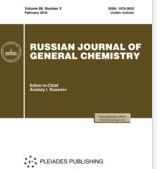 |
Abstract. A series of closo-decaborate anions containing an O-iminoacylamide oxime fragment were synthesized by nucleophilic addition of aromatic amide oximes to 2-propionitrilium closo-decaborate anion. The isolated compounds were characterized by IR, 1H, 13C–{1H}, and 11B–{1H} NMR, and mass spectra. The structure of (Ph4P)[2-B10H9NH=C(Et)ON=C(NH2)C6H4Me-2] was determined by single-crystal X-ray analysis. |
| 27 |
Mariia M. Efremova, Rafael R. Kostikov, Alexander V. Stepakov, Taras L. Panikorovsky, Victoriya S. Shcherbakova b, Andrey V. Ivanov b, Alexander P. Molchanov «Unusual Lewis-acid catalyzed formal (3+3)-cycloaddition of azomethine imines and nitrones to N-vinylpyrroles», Tetrahedron, 2017,73, 671-680DOI: 10.1016/j.tet.2016.12.034 |
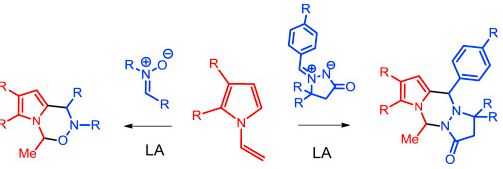 |
Abstract. The addition of Lewis acids change the reaction mechanism of the cycloaddition of N-vinylpyrroles with azomethine imine and C,N-diarylnitrones. The formal (3+3)-cycloaddition is observed instead of (3+2)-dipolar cycloaddition, which take place in the absence of catalysts. This unusual (3+3)-cycloaddition leads to heterocyclic compounds with pyrazolo[1,2-a]pyrrolo[1,2-d][1,2,4]triazine- and pyrrolo[2,1-d][1,2,5]oxadiazine cores, which are difficultly achievable by other methods. |
| 28 |
Anatoly A. Vereschagin, Vladimir V. Sizov, Petr S. Vlasov, Elena V. Alekseeva, Alexander S. Konev, Oleg V. Levin «Water-stable [Ni(salen)]-type electrode material based on phenylazosubstituted salicylic aldehyde imine ligand», New Journal of Chemistry, 2017,41, 13918 – 13928DOI: 10.1039/c7nj03526h |
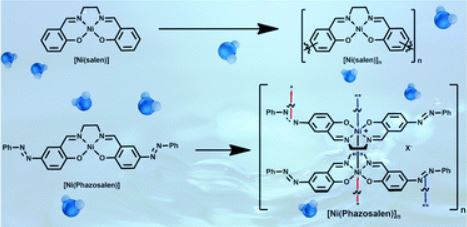 |
Abstract. A novel electrode material was prepared by electrochemical oxidation of [4,4′-phenylazo-2,2′-(ethylenediimino-κ2N-methyl)diphenolate-κ2O]nickel, a [Ni(II)(salen)]-type complex, in chlorinated solvent. The chemical structure of the material was explored by FTIR, NMR and XPS techniques to determine the main components of the material and the nature of the linkage between them. The morphology of the material films was explored by SEM analysis. The electrochemical properties of the new material were studied by a set of voltammetric methods and an unusual stability of the material in aqueous medium was observed. |
| 29 |
О.М.Нестерова, О.С.Зарубина, В.В.Толстяков, Г.Г.Данагулян, Р.Е.Трифонов, С.Н.Смирнов, П.А.Слепухин, Н.К.Игнатенко, В.А.Островский «СИНТЕЗ И СТРОЕНИЕ N-(4,6-ДИМЕТИЛПИРИМИДИН-2-ИЛ)-2-(5-ФЕНИЛ- 2Н-ТЕТРАЗОЛ-2-ИЛ)АЦЕТОГИДРАЗИДА И 1-(4,6-ДИМЕТИЛПИРИМИДИН-2-ИЛ)- 3-[(5-ФЕНИЛ-2Н-ТЕТРАЗОЛ-2-ИЛ)МЕТИЛ]-1Н-ПИРАЗОЛ-5-ОЛА», ЖУРНАЛ ОРГАНИЧЕСКОЙ ХИМИИ, 2017, 11, 1726-1728 |
| |
Abstract. Синтезированы новые тетразолильные производные 4,6-диметилгидразина, содержащие различные линкерные группы. Определена структура данных соединений методами ЯМР спектроскопии и рентгеноструктурного анализа. |
| 30 |
Mikhail A. Kinzhalov , Alina S. Legkodukh, Tatyana B. Anisimova, Alexander S. Novikov, Vitalii V. Suslonov, Konstantin V. Luzyanin , and Vadim Yu. Kukushkin «Tetrazol-5-ylidene Gold(III) Complexes frоm Sequential [2 + 3] Cycloaddition of Azide to Metal-Bound Isocyanides and N4 Alkylation», Organometallics, 2017,36 3974–3980 DOI: 10.1021/acs.organomet.7b00591 |
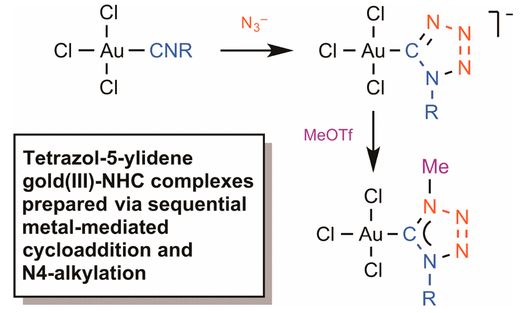 |
Abstract. The reaction between equimolar amounts of the isocyanide complexes [AuCl3(CNR)] [R = 2,6-Me2C6H3 (Xyl), 1a; 2,4,6-Me3C6H2 (Mes), 1b; Cy, 1c; t-Bu, 1d] and tetrabutylammonium azide (2) proceeds in CH2Cl2 at room temperature for ∼10 min to furnish the gold(III) tetrazolates [n-Bu4N][AuCl3(CN4R)] (3a–d), which were obtained in 89–95% yields after purification. Subsequent reaction between equimolar amounts of 3a–d and methyl trifluoromethanesulfonate (MeOTf) proceeds in CH2Cl2 at −70 °C for ∼30 min to give the corresponding gold(III) complexes [AuCl3(CaN(Me)N2NbR)]a–b (5a–d) bearing 1,4-disubstituted tetrazol-5-ylidene ligands (69–75%). Complexes 3a–d were obtained as pale-yellow solids and characterized by elemental analyses (C, H, N), HRESI–-MS, FTIR, and 1H and 13C{1H} NMR spectroscopies. Complexes 5a–d were obtained as colorless solids and characterized by elemental analyses (C, H, N), HRESI+-MS, and 1D (1H and 13C{1H}) and 2D (1H,13C-HMBC) NMR spectroscopies. In addition, the structures of 3a, 3b, 3c, and 5a were established by single-crystal X-ray diffraction. Analysis of the Wiberg bond indices (WI) for gas phase-optimized model structures of 3a–c and 5a computed using the natural bond orbital (NBO) partitioning scheme disclosed a higher degree of electron density delocalization in the CN4 moiety of carbene 5a when compared to tetrazolate 3a–c. Results of DFT calculations for a model system reveal that the mechanism for the cycloaddition of an azide to the isocyanide ligand in [AuCl3(CNMe)] is stepwise and involves nucleophilic attack of N3– on the N atom of CNMe followed by ring closure. The addition is both kinetically and thermodynamically favorable and occurs via the formation of an acyclic NNNCN intermediate, whereas the cyclization is the rate-determining step. |
| 31 |
Svetlana A. Katkova, Mikhail A. Kinzhalov, Peter M. Tolstoy, Alexander S. Novikov , Vadim P. Boyarskiy, Anastasiia Yu. Ananyan, Pavel V. Gushchin, Matti Haukka§, Andrey A. Zolotarev, Alexander Yu. Ivanov, Semen S. Zlotsky, and Vadim Yu. Kukushkin «Diversity of Isomerization Patterns and Protolytic Forms in Aminocarbene PdII and PtII Complexes Formed upon Addition of N,N′-Diphenylguanidine to Metal-Activated Isocyanides», Organometallics, 2017,36, 4145–4159 DOI: 10.1021/acs.organomet.7b00569 |
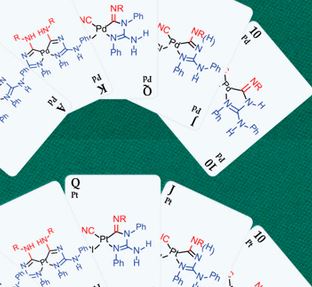 |
Abstract. Reaction of the palladium(II) and platinum(II) isocyanide complexes cis-[MCl2(CNR)2] [M = Pd, R = C6H3(2,6-Me2) (Xyl), 2-Cl-6-MeC6H3, cyclohexyl (Cy), t-Bu, C(Me)2CH2(Me)3 (1,1,3,3-tetramethylbuth-1-yl abbreviated as tmbu); M = Pt, R = Xyl, 2-Cl-6-MeC6H3, Cy, t-Bu, and tmbu] with N,N′-diphenylguanidine (DPG) leads to DPG-derived metal-bound deprotonated acyclic diaminocarbene (ADC) species. This reaction occurs via a two-step process, involving the initial coupling of the guanidine with one of the isocyanides and leading to deprotonated monocarbene monochelated species, while the next addition grants the deprotonated bis-carbene bis-chelated metal compounds. DPG behaves as nucleophile, deprotonating base, and chelator. The addition of DPG proceeded with different regioselectivity depending on the metal center and, in a larger extent, on the substituent R in RNCs. The X-ray diffraction studies for the deprotonated mono- and bis-carbene complexes confirmed the regioisomerism of these species and allowed the identification of ADC protolytic forms stabilized in the solid-state. 1D (1H and 13C{1H}) and 2D (1H,1H-NOESY; 1H,15N-HSQC; 1H,15N-HMBC) solution NMR of the obtained systems demonstrated their configuration isomerism accompanied by prototropic tautomerism. Together, the solid-state and solution data provide an insight into the flexible character of ADC species. |
| 32 |
M. M. Efremova, R. R. Kostikov, A. G. Larina, A. P. Molchanov «Regio- and Stereosеlеctive (3 + 2)-Cycloaddition of Nitrile Oxides and Nitrones to N-Vinylindole», Russian Journal of Organic Chemistry, 2017, 53, 246 – 250 DOI: 10.1134/S107042801702018X |
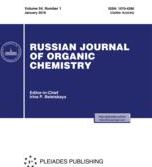 |
Abstract. 1,3-Dipolar cycloaddition of nitrile oxides and nitrones to N-vinylindole proceeds regioselectively at the exocyclic multiple bond to form 5-indolyl-substituted isoxazolines and isoxazolidines in good yields. |
| 33 |
Ekaterina V. Sirotkina, Mariia M. Efremova, Alexander S. Novikov, Vladimir V. Zarubaev, Iana R. Orshanskaya, Galina L. Starova, Rafael R. Kostikov, Alexander P. Molchanov « Regio- and diastereosеlеctivity of the cycloaddition of aldonitrones with benzylidenecyclopropane: An experimental and theoretical study», Tetrahedron, 2017, 73, 3025-3030 DOI: 10.1016/j.tet.2017.04.014 |
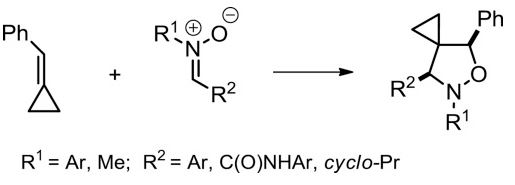 |
Abstract. 1,3-Dipolar cycloaddition of benzylidenecyclopropane with various aldonitrones proceeds regioselectively giving good yields of 4-spirocyclopropane isoxazolidines. In the case of aldonitrones, bearing carbamoyl- or aryl-groups on the carbon atom, only the cis-isomer is formed. The compounds synthesized were tested for their virus-inhibiting activity. |
| 34 |
Smirnov, Andrey S.; Nikolaev, Dmitriy N. ; Gurzhiy, Vlad V.; Smirnov, Sergey N.; Suslonov, Vitaliy S.; Garabadzhiu, Alexander V.; Davidovich, Pavel B. « Conformational stabilization of isatin Schiff bases – biologically active chemical probes.», RSC Advances, 2017, 17, 10070-10073 DOI: 10.1039/C6RA26779C |
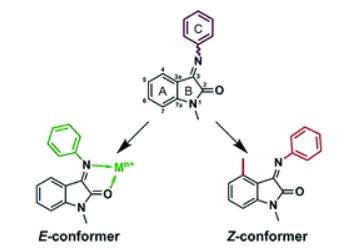 |
Abstract. Isatin Schiff base derivatives have a wide range of biological effects. Unfortunately, these compounds possess a serious topological shortcoming: the conformational E ⇆ Z interconversion. Two ways of conformation stabilization are reported here: complexation with metals that stabilize the E-conformer and substitution in the 4th position of the isatin core stabilizing the Z-form. |
| 35 |
Е. А. Костенко, Е. В. Елисеенков, А. А. Петров « Закономерности восстановления трихлорбифенилов пропан-2-олом В основной среде при катализе pd/c», Журнал Общей Химии, 2017, 8, 1239-1246 |
| |
Abstract. Изучено восстановление ряда трихлорбифенилов пропан-2-олом в основной среде при катализе Pd/C. Определена региоселективность восстановления. Во всех изученных случаях наиболее реакционноспособным является атом хлора в пара- и мета-положениях наиболее замещенного ядра. С использованием метода меченых атомов показано, что реакция протекает через стадию дегидрирования пропан-2-ола на палладиевом катализаторе с последующим каталитическим гидрированием полихлорбифенилов. |
| 36 |
V. P. Boyarskii « Sonogashira reaction catalyzed by palladium isocyanide complex modified in situ», Russ. J. Gen. Chem., 2017, 87(8),1663–1666 DOI: 10.1134/S1070363216090085 |
 |
Abstract. Acyclic diaminocarbene palladium complexes generated in situ by nucleophilic attack of morpholine, 4-nitrophenylhydrazine, or benzhydrazide on bis(isocyanide) palladium(II) complexes catalyzed the Suzuki reaction of 4-iodo- or 4-bromoanisole with phenylboronic acid. Morpholine turned out to be the best catalyst modifier. The cross coupling reaction under fairly mild conditions (reflux in ethanol in the presence of potassium carbonate) in 2 h afforded 4-methoxybiphenyl whose yield was insignificantly lower than in the presence of preliminarily prepared catalyst. Neither preliminary degassing nor protection from atmospheric moisture and oxygen was necessary. |
| 37 |
M.A. Lytkina, E.V. Eliseenkov, V.P. Boyarskii, A.A. Petrov « Sodium Difluoromethanesulfinate—A Difluoromethylating Agent toward Protonated Heterocyclic Bases», Russian Journal of Organic Chemistry, 2017,4, 539-546 DOI: 10.1134/S1070428017040066 |
 |
Abstract.Free radical difluoromethylation of protonated heteroaromatic bases was accomplished using sodium difluoromethanesulfinate in combination with tert-butyl hydroperoxide in a two-phase system (methylene chloride–water) at room temperature. The difluoromethylation products of methyl pyridine-4-carboxylate, pyridine-4-carbonitrile, and 2-amino-1,3,4-thiadiazole were isolated on a preparative scale. |
| 38 |
K. V. Zavyalov, M. S. Novikov, А. F. Khlebnikov, N. V. Rostovskii, and G. L. Starova « Rh2(OAc)4-Сatalyzed Reaction of 2-(2-Carbonylvinyl)- 3-phenyl-2Н-azirines with Diazo Esters», Russian Journal of Organic Chemistry, 2017,53(8), 1214–1221 DOI: 10.1134/S1070428017080097 |
 |
Abstract. <Rh2(OAc)4-catalyzed reaction of 2-(2-carbonylvinyl)-3-phenyl-2H-azirines with diazo esters proceeds through an intermediate generation of azirinium ylide suffering a nonstereoselective ring opening to form (3Z)- and (3E)-2-azahexa-1,3,5-trienes. The former depending on configuration of the C 5 =C 6 bond may undergo cyclization either in derivative of 2,3-dihydropyridine, or in pyrrolium ylide that isomerizes into a derivative of 1H-pyrrole. According to DFT calculation, the preferred formation of pyrroles at increasing volume of Z-substituent at the atom C 6 and of substituents at the atom C 1 of 2-azahexatriene occurs due to the destabilization of more sterically loaded transition states of 1,6-cyclization. |
| 39 |
P. A. Sakharov, N. V. Rostovskii, A. F. Khlebnikov, M. S. Novikov « Annulation of five-membered cyclic enols with 3-aryl-2H-azirines: Catalytic versus non-catalytic cycloaddition»,Tetrahedron, 2017,73, 4663-4670 DOI: 10.1016/j.tet.2017.06.037 |
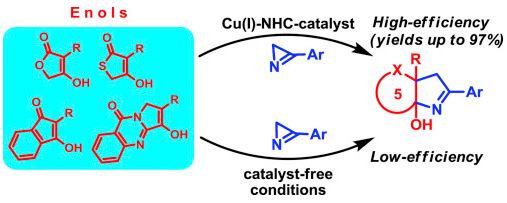 |
Abstract. <A copper(I)-NHC-catalyzed annulation of 5-membered cyclic enols of furan, thiophene and indene family with 3-aryl-2H-azirines has been developed to provide a rapid access to furo[3,4-b]pyrrole, thieno[3,4-b]pyrrole, indeno[1,2-b]pyrrole derivatives. The reaction proceeds via a copper-initiated NC2 azirine bond cleavage with the retention of the CN double bond in the annulation product. The reaction of tetronic acids with 3-aryl-2H-azirines can also proceed under catalyst-free conditions, through a double addition of the enol to the azirine, but this route provides poor yields of the annulation products. This is the first example of the NC2 bond cleavage in 2-unsubstituted 2H-azirines in the absence of a transition metal catalyst. |
| 40 |
Aleksandra V. Protas, Elena A. Popova, Vitalii V. Suslonov, Rostislav E. Trifonov «Novel water soluble palladium(II) complexes featuring tetrazolylacetic acids and their esters»,Polyhedron, 2017,124 131-138 DOI: 10.1016/j.poly.2016.12.032 |
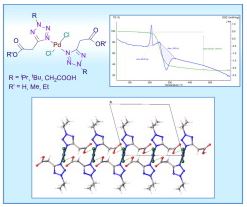 |
Abstract. <2-R-2H-Tetrazol-5-ylacetic acids (R = iso-Pr, tert-Bu, CH2COOH) (1a–c) react with PdCl2 in 5% (w/w) MeOH in 1 M HCl furnishing the palladium(II) water soluble complexes trans-[PdCl2L2] (2a–c). In the presence of EtOH in the reaction mixture, esterification of the tetrazolylacetoxy groups occurs leading to trans-[PdCl2(ethyl 2-R-2H-tetrazol-5-ylacetate)2] (3a–c). In the case of reaction of 2-tert-butyl-tetrazol-5-ylacetic acid 1b with PdCl2 increasing of the proportion of methanol up to 50% (w/w) led to the esterification to give trans-[PdCl2(methyl 2-tert-butyl-tetrazol-5-ylacetate)2] 4b. Complexation of isomeric 5-methyl-1H-tetrazol-1-ylacetic acid 5 with PdCl2 at the same conditions leads to trans-[PdCl2(5-methyl-1H-tetrazol-1-ylacetic acid)2] 6 and trans-[PdCl2(ethyl 2-(5-methyl-1H-tetrazol-1-yl)acetate)2] 7. The complexes obtained were characterized by HRESI+-MS, 1H, 13C{1H} NMR, and IR spectroscopies as well as by X-ray diffraction (for 2a, 3a, 3b, 4b and 6·H2O). According DSC/TG analysis the thermal decomposition of the complexes occurs by the same mechanism similar to that of the free ligands. In all cases it starts with evolution of molecular nitrogen from the tetrazole ligand which is accompanied by an exothermic effect. |
| 41 |
N.G. Voron’ko, S.R. Derkach, M.A. Vovk, P.M. Tolstoy « Complexation of kappa-carrageenan with gelatin in the aqueous phaseanalysed by1H NMR kinetics and relaxation»,Carbohydrate Polymers, 2017,169, 117-126 DOI: 10.1016/j.carbpol.2017.04.010 |
 |
Abstract. <The 1H NMR spectroscopy is used to study the kinetics of gelation in the aqueous mixtures of κ-carrageenan with gelatin. The time dependence of NMR signals intensities shows that the kinetics of gel formation consists of classical ‘fast’ (rate constant k ≈ 6 h−1) and ‘slow’ (k ≈ 1 h−1) periods, corresponding to a coil → helix transition and subsequent aggregation of helices. Upon increase of the κ-carrageenan/gelatin (w/w) ratio Z the rate of the fast process slows down by a factor of 1.6–2.4. Further analysis was done by studying the dependence of spin-spin relaxation times of protons of gelatin on Z in the aqueous phase. A qualitative scheme describing hydrogel formation in the complex solution is given. It is hypothesized that at higher concentration of PECs the hydrogel structure network is stabilized by three types of nodes: triple helices of gelatin and intra-/inter-molecular double helices of κ-carrageenan. |
| 42 |
V.A. Rozentsvet, V.G. Kozlov, O.A. Stotskaya, N.A. Sablina, V.P. Ivanova, P.M. Tolstoy « Kinetic parameters of cationic polymerization of 1,3-dienes», Russian Chemical Bulletin, International Edition, 2017, 66(6) 1088-1093 |
| |
Abstract. <A new technique for the determination of the concentration of active centers of polymerization and propagation rate constants for processes of cationic polymerization of conjugated dienes was proposed. The method consists of the quantitative calculation from the 13C NMR spectra of the concentration of the initial units of the polymer chain polydienes synthesized at diff erent monomer conversions and the subsequent extrapolation of the obtained values to the zero monomer conversion. Using the proposed procedure, the chain propagation rate constants were determined for the cationic polymerization of isoprene and 1,3-pentadiene in the presence of a titanium tetrachloride–tert-butyl chloride catalytic system. |
| 43 |
A.A. Osipov, V.E. Eremyashev, A.S. Mazur, P.M. Tolstoi, L.M. Osipova «Structure of Cesium-Borosilicate Glasses According to NMR Spectroscopy»,Glass Physics and Chemistry, 2017, 43(4), 287-293 DOI: 10.1134/S1087659617040113 |
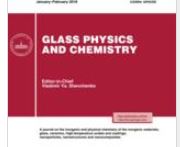 |
Abstract. <The local structure of cesium-borosilicate glasses with various Cs2O and B2O3 proportions and constant SiO2 content (50 mol %) is studied with 11B, 29Si, and 133Cs MAS NMR spectroscopy. The portions of three- and four-fold Si atoms are determined, as well as the concentrations of various silicate Q n units. Our experimental data are compared with the predictions of Dell’s model and thermodynamic modeling for sodium–borosilicate analogs of the glasses studied. |
| 44 |
M. Brusnikina, O. Silyukov, M. Chislov, T. Volkova, A. Proshin, A. Mazur, P. Tolstoy, I. Terekhova «Effect of cyclodextrin complexation on solubility of novel anti-Alzheimer 1,2,4-thiadiazole derivative»,Journal of Thermal Analysis and Calorimetry, 2017,130, 443-450 DOI: 10.1007/s10973-017-6252-1 |
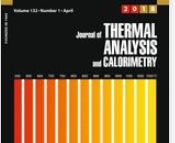 |
Abstract. <New 1,2,4-thiadiazole derivative displaying neuroprotective potential and high activity in the treatment of Alzheimer’s disease has been synthesized. The objective of this study was to improve the aqueous solubility of this drug-like compound by means of complex formation with native and hydroxypropylated β-cyclodextrins. To this end, aqueous solubility of 1,2,4-thiadiazole derivative was investigated in the presence of β-cyclodextrins. It was shown that the phase solubility diagrams are of Bs type demonstrating the initial increase in thiadiazole solubility in solutions of cyclodextrins (concentration up to 0.01 mol kg−1) followed by a solubility decrease due to the precipitation of the complexes formed. In comparison with β-cyclodextrin, hydroxypropyl-β-cyclodextrin displays more pronounced solubilizing action since it forms more stable complexes with thiadiazole. Solid complexes of 1,2,4-thiadiazole derivative with β-cyclodextrins were prepared by grinding and freeze-drying methods. DSC, TG, hot-stage microscopy, solid-state 13C MAS CP/TOSS NMR, powder X-ray diffractometry and FTIR spectroscopy were used to prove the existence of complexes in the solid state. Solubility of the obtained formulations was also examined. It was found that complexes of thiadiazole with hydroxypropyl-β-cyclodextrin exhibited higher solubility in phosphate buffer (pH 7.4) compared with pure thiadiazole and its complexes with β-cyclodextrin. |
| 45 |
Dmitrii Gordeychuk, Vladimir Kochemirovsky, Victor Sorokoumov, Ilya Tumkin, Alexey Kuzmin and Irina Balova «Copper Particles Generated During in situ Laser-induced Synthesis Exhibit Catalytic Activity Towards Formation of Gas Phase»,JLMN-Journal of Laser Micro/Nanoengineering, 2017,12(2), 57-61 DOI: 10.2961/jlmn.2017.02.0001 |
 |
Abstract. <The method of laser-induced chemical deposition of metal from solution was applied in the continuous in situ laser generation of metal copper catalysts for model organic synthesis reactions. The gas phase products producing during laser-induced copper deposition were analyzed by gas mass spectroscopy whereas solutions used for the copper deposition were investigated before and after laser irradiation using chromato-mass and NMR spectroscopy. It was found out that the catalysis of the studied organic reactions by metal catalysts generated during laser deposition process occurs only upon laser irradiation of the reaction mixture, in turn, the copper structures deposited under laser light exhibit no catalytic activity |
| 46 |
A.V. Artem’ev, I.Yu. Bagryanskaya, E.P. Doronina, P.M. Tolstoy, A.L. Gushchin, M.I. Rakhmanova, A.Yu. Ivanov, A.O. Suturina « A new family of clusters containing a silver-centered tetracapped [Ag@Ag4(μ3-P)4] tetrahedron, inscribed within a N12 icosahedron», Dalton Transactions, 2017,46, 12425-12429 DOI: 10.1039/C7DT02597a |
 |
Abstract. <An unprecedented silver-centered P-tetracapped [Ag@Ag4(μ3-P)4] tetrahedron inscribed within a N12 icosahedral cage has been discovered in the novel family of luminescent clusters. The latter are easily self-assembled by reacting AgI salts with tris(2-pyridyl)phosphine (Py3P). |
| 47 |
V.A. Rozentsvet, O.A. Stotskaya, V.P. Ivanova, M.G. Kuznetsova, P.M. Tolstoy, S.V. Kostjuk «Structural сhаracterization of Polybutadiene Synthesized via Cationic Mechanism»,Journal of Polymer Science, Part A: Polymer Chemistry, 2017 DOI: 10.1002/pola.28905 |
 |
Abstract. <The microstructure of polybutadiene synthesized via cationic polymerization using TiCl4‐based initiating systems has been investigated using 1D (1Н, 2Н, and 13С) and 2D (HSQC and HMBC) NMR spectroscopy. It was found that trans‐1,4‐unit is predominant structure of unsaturated part of polymer chain. Besides, the small amount of 1,2‐structures was also detected, while cis‐1,4‐units were totally absent. The signals of carbon atoms of three types of head groups (trans‐1,4‐, 1,2‐, and tert‐butyl) and two types of end groups (trans‐1,4‐Cl and 1,2‐Cl) were identified for the first time in macromolecules of cationic polybutadiene. It was showed that tert‐butyl head groups were formed due to the presence in monomer of admixtures of isobutylene. The new methodology for calculation of the content of different structural units in polybutadiene chain as well as the head and end groups was proposed. It was established that main part of 1,2‐units distributed randomly along the polybutadiene chain as separate units between trans‐1,4‐structures. |
| 48 |
P. Mäki-Arvela, J. Zhu, N. Kumar, K. Eränen, A. Aho, J. Linden, J. Salonen, M. Peurla, A. Mazur, V. Matveev, D.Yu. Murzin « Solvent-free “green” amidation of stearic acid for synthesis of biologically active alkylamides over iron supported heterogeneous catalysts», Applied Catalysis A, General, 2017, 542, 350-358 DOI: 10.1016/j.apcata.2017.06.006 |
 |
Abstract. <Stearoyl ethanolamine was synthesized by amidation of stearic acid with ethanolamine in solventless conditions. Iron containing heterogeneous catalysts supported on SiO2, Al2O3, Beta (BEA), ZSM-12 (MTW) and Ferrierite (FER) were used in this work. Sn-modified Ferrierite and H-Ferrierite were also studied for comparison. Fe-modified catalysts synthesized using solid state ion-exchange and evaporation impregnation methods, were thoroughly characterized with X-ray powder diffraction, scanning electron microscope, FTIR with pyridine, nitrogen adsorption, energy dispersive X-ray microanalysis and Mössbauer spectroscopy. The highest conversion was obtained with Fe-H-FER-20 at 140 °C in 1 h giving 61% conversion and 98% selectivity towards the desired amide. The catalytic performance in terms of turnover frequency per mole of iron was achieved with the catalyst exhibiting the largest amount of Fe3+ species, optimum acidity and a relatively low Brønsted to Lewis acid site ratio. |
| 49 |
V.V. Tomaeva, A.S. Mazur, A.S. Grevtsev « A Study of the Process of Thermal Oxidation of Lead Selenide by the NMR and XRD Methods», Glass Physics and Chemistry, 2017, 43(1), 70-74 DOI: 10.1134/S1087659617010163 |
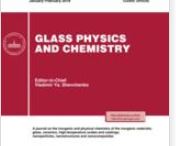 |
Abstract. <Studies of the process of oxidation of powder samples of lead selenide in a dry air atmosphere have been performed. As shown by the methods of X-ray diffraction and scanning electron microscopy, the process of thermal treatment of samples resulted in the formation of the PbSeO3 phase, aside from the initial PbSe phase. Studies by the method of nuclear magnetic response (NMR) allowed revealing the dynamics of changes in the spectrum under the changed thermal treatment conditions. |
| 50 |
Т.Н. Тарасенко, З.Ф. Кравченко, В.В. Бурховецкий, А.С. Мазур, В.И. Каменев, А.И. Линник «Синтез, микроструктура, сложный характер магнитного состояния слаболегированного висмутом манганита лантана», Известия РАН, серия физическая, 2017,81(3), 344-348 DOI: 10.7868/S036767651703036X |
| |
Abstract. <Проведены структурные, магнитные и резонансные исследования манганитов BixLa1 – xMnO3. Золь–гель-методом получены нанопорошки слаболегированных составов (x = 0.0–0.1) с размером частиц ≤40 нм. При спекании в одинаковых условиях средний размер гранул резко растет с ростом содержания Bi. Спектры ЯМР манганитов твердофазного синтеза 55Mn отвечают условию быстрого обмена Mn4+ ↔ Mn3+. Измерение магнитной восприимчивости обнаружило неоднородность магнитного состояния системы BixLa1 – xMnO3 |
| 51 |
D.S. Mazing, A.V. Nikiforova, A.S. Osinin, V.A. Moshnikov, Yu.V. Bogachev, S.M. Sukharzhevskii «Electron Paramagnetic Resonance Investigations of ZnSe:Mn Nanocrystals», Applied Magnetic Resonance, 2017, 48, 731-737 DOI: 10.1007/s00723-017-0898-5 |
 |
Abstract. <Colloidal nanocrystals of ZnSe doped with Mn2+ were synthesized in non-polar medium using hot-injection technique. Obtained samples were characterized by means of photoluminescence and absorption spectroscopies. To confirm the incorporation of Mn2+ impurity and to reveal its state and localization, electron paramagnetic resonance (EPR) spectroscopy was employed. As a result, EPR spectra were analyzed and hyperfine splitting constant and g-factor for Mn2+ dopant were determined. |
| 52 |
В.Н. Демидов, С.М. Сухаржевский, С.В. Пастон, А.В. Зинченко, Л.Н. Веденеева, Т.Б. Пахомова « Термоиндуцированные S0 – T-переходы в электрон-избыточных 1,10-фенантроцианинах Zn(II), комплексонах ДНК, содержащих дигидро-1,10-фенантролиновые циклы, родственные NADH», Вестник СПбГУ. Физика и химия, 2017, 4(62), 138-145 |
| |
Abstract. С помощью спектроскопии ЭПР изучено проявление парамагнитных свойств для электрон-избыточных 1,10-фенантроцианиновых комплексов Zn(II): [(phen)2Zn(μ-phencyanine) Zn(phen)2](OAc)4 (Zn1), [(phen)2Zn(μ-phencyanine−)Zn(phen)2](OAc)3 (Zn2), (phen)Zn(μ-
phencyanine−)Zn(phen)(OAc)3 (Zn3), (en)Zn(μ-phencyanine−)Zn(en)(OAc)3 (Zn4) и Zn(μ-phencyanine−)Zn(OAc)3 (Zn5) (phen — 1,10-фенантролин, en — этилендиамин, OAc− — ацетатный ион, μ-phencyanine и μ-phencyanine− — мостиковые 1,10-фенантроцианины, дигидро-би-1,10-фенантролины), комплексонов ДНК, содержащих родственные NADH дигидро-1,10-фе-нантролиновые циклы. Соединения Zn1–Zn5 получены с использованием методологии металл-опосредуемого недегидрогенативного CH−CH-сочетания координированного 1,10-фенантролина в ионных расплавах соответствующих комплексов-предшественников. В ЭПР
спектрах полученных 1,10-фенантроцианинов Zn(II) обнаружены сигналы в области значений g-фактора 2,0018–2,0031 с неожиданно высокой интенсивностью. Установлено аномальное увеличение интенсивности линий ЭПР с ростом температуры от 77 до 450 К. Появление парамагнетизма для этих соединений соотнесено с их электрон-избыточной природой и интерпретировано как результат термоиндуцированных S0 → T-переходов, которые можно связать со структурными фазовыми превращениями. |
| 53 |
E.I. Evstigneyev, A.V. Kalugina, A.Yu. Ivanov, A.V. Vasilyev «Contents of α-o-4 and β-o-4 bonds in native lignin and isolated lignin preparations»,Journal of Wood Chemistry and Technology, 2017,37(4), 294-306 DOI: 10.1080/02773813.2017.1297832 |
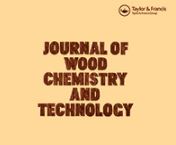 |
Abstract.An analytical calculation method for the estimation of the contents of alkyl aryl ether bonds (α-O-4 and β-O-4) in lignin was developed. In the framework of the method, Alkyl–O–Aryl type bonds are described as coupled phenolic hydroxyls (OHphen). The method is based on the balance equation including the free and coupled OHphen contents in dissolved and residual lignins, on the one hand, and their respective contents in native lignin, on the other. The free OHphen content is calculated on the basis of the OHphen contents of dissolved and residual lignin, determined by the aminolysis method in the course of kraft cooking of softwood. The calculation results for soluble lignin preparations are in good agreement with the 13C NMR (nuclear magnetic resonance) spectral data for the solutions. The content of Alkyl–O–Aryl bonds in native softwood (pine, spruce) lignin was estimated at 79/100 PPU (phenylpropane unit). In isolated lignin preparations, the contents of these bonds decrease in the sequence: Freudenberg lignin (71/100 PPU)> Bjorkman lignin (61/100 PPU)> Pepper lignin (44/100 PPU). Dissolved alkaline lignin still contains small amounts of Alkyl–O–Aryl bonds (36/100 PPU in soda lignin and an average of 23/100 PPU in soda-AQ lignin, kraft lignin, and kraft-AQ lignin). Residual lignin which represents the fraction of native lignin with inter-unit bonds resistant to kraft pulping contains 66/100 PPU of such bonds. A relatively high content of Alkyl–O–Aryl bonds (61/100 PPU) is preserved in technical hydrolysis lignins. |
| 54 |
Valentin A. Rassadin, Mirko Scholz, Anastasiia A. Klochkova, Armin de Meijere, Victor V. Sokolov « Synthesis of benzannelated sultams by intramolecular Pd-catalyzed arylation of tertiary sulfonamides»,Beilstein Journal of Organic Chemistry, 2017, 13, 1932–1939 DOI: 10.3762/bjoc.13.187 |
 |
Abstract.A new and efficient approach to five- and six-membered benzannelated sultams by intramolecular C-arylation of tertiary 1-(methoxycarbonyl)methanesulfonamides under palladium catalysis is described. In case of the α-toluenesulfonamide derivative, an unexpected formation of a 2,3-diarylindole was observed under the same conditions. |
| 55 |
V.S. Fundamensky, T.A. Kochina, Y.A. Kondratenko, A.A. Zolotarev, Yu.G. Vlasov, I.S. Ignatyev « Iоnic liquids based on triethanolammonium salts of dicarboxylic acids (oxalic, malonic, succinic). Crystal structure and cation-anion interaction»,Journal of Molecular Liquids, 2017, 230, 113-120 DOI: 10.1016/j.molliq.2016.12.111 |
 |
Abstract.The series of ionic liquids based on triethanolammonium salts of dicarboxylic acids (oxalic, malonic and succinic) was synthesized, characterized by IR and H1, C13 NMR spectroscopy, thermogravimetric analysis (TGA) and differential scanning calorimetry (DSC). Their structure was determined by single-crystal X-ray diffraction. It was found that triethanolammonium [(HOCH2CH2)3NH]+ cations in salts of oxalic (1), malonic (2) and succinic acids (3) containing monoanions [OOC(CH2)nCOOH]− (n = 0–2) have the endo conformation and the ammonium proton (Ham) resides inside the “lampshade” formed by three CH2CH2OH branches connected with nitrogen atom. The asymmetric cell of the second modification of the succinic acid salt (4) includes two triethanolammonium cations and a succinate dianion [(HOCH2CH2)3NH]2+[OOC(CH2)2COO]2 −. In this salt (4) one CH2CH2OH branch of the triethanolammonium cation is rotated around the NC bond (endo-exo conformation) and forms infinite TEA chains. This pattern was firstly found in organic salts of TEA. The obtained results show that different structures of triethanolammonium cations in the salts of dicarboxylic acids have significant influence on the cation-anion interaction. |
| 56 |
A.A. Vdovchenko, A.V. Hubina, E.G. Vlakh, T.B. Tennikova « Self-assembled polymer particles based on thermoresponsive biodegradable copolymers of amino acids», Mendeleev Communications, 2017, 27, 153-154DOI: 10.1016/j.mencom.2017.03.015 |
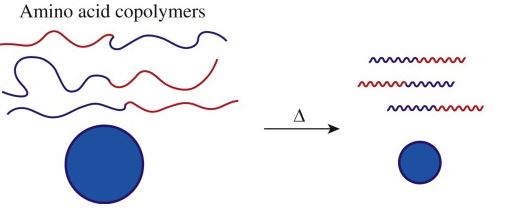 |
Abstract.Thermoresponsive amphiphilic PGlu30-b-PSert-PSer(OCONHPh)p copolymers with different hydrophobic unit content were synthesized, characterized and applied for preparation of biodegradable soft particles. |
| 57 |
Tatyana B. Anisimova, a Mikhail A. Kinzhalov, b M. Fa´tima C. Guedes da Silva, a Alexander S. Novikov, b Vadim Yu. Kukushkin, b Armando J. L. Pombeiro a and Konstantin V. Luzyanin « Addition of N-nucleophiles to gold(III)-bound isocyanides leading to short-lived gold(III) acyclic diaminocarbene complexes», New J. Chem., 2017, 41, 3246DOI: 10.1039/c7nj00529f |
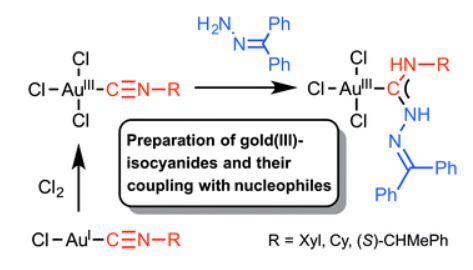 |
Abstract.Reaction of [AuCl3(CNR1)] (R1 = Xyl, Cy, (S)-CHMePh) with amines unexpectedly proceeds via the redox pathway giving gold(I)–isocyanides and imines, while the addition of benzophenone hydrazone to the isocyanide ligand in [AuCl3(CNR1)] at RT leads to short-lived gold(III) acyclic diaminocarbene complexes [AuCl3{C(NHNCPh2)NHR1}]. |
| 58 |
Regina M. Islamova, Mikhail V. Dobrynin, Andrey V. Vlasov, Anzhelika A. Eremina, Mikhail A. Kinzhalov, Ilya E. Kolesnikov, Andrey A. Zolotarev, Eleonora A. Masloborodova and Konstantin V. Luzyanin « Iridium(III)-catalysed cross-linking of polysiloxanes leading to the thermally resistant luminescent silicone rubbers», Catalysis Science & Technology, 2017, 7, 5843-5846 DOI: 10.1039/c7cy02013a |
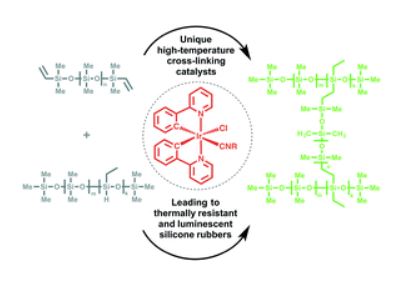 |
Abstract.Cyclometallated iridium(III) complexes with 2-phenylpyridine [Ir(ppy)2(CNR)Cl] (ppy = (2-phenylpyridinato-C2,N), R = Xyl, Mes), [Ir(ppy)2(CNR)2](OTf) (R = Xyl, Mes), and fac-[Ir(ppy)3] catalyse the cross-linking of polysiloxanes exclusively at temperatures above 100 °C leading to luminescent rubbers. |
| 59 |
E. A. Katlenok, M. A. Kinzhalov, A. A. Eremina, and K. P. Balashev «Оptical and Electrochemical сhаracteristics of Ir(III) Complexes with Metalated 4-(4-Bromophenyl)-2-Methyl-1,3-Thiazole and Isocyanide, Ethylenediamine, and Diethyldithiocarbamate Ligands», Optics and Spectroscopy, 2017,122 723-728 DOI: 10.1134/S0030400X17050113 |
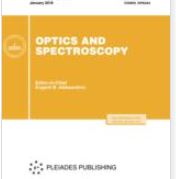 |
Abstract.The influence of donor–acceptor properties of tert-butyl-, 2.6-dimethylphenyl-, and 4-bromophenyl-isocyanides (BuNC, XylNC, BpNC), ethylenediamine (En), and diethyldithiocarbamate ions (Dtc–) on the 1H and 13C NMR, IR, optical, and electrochemical characteristics of Ir(III) complexes with metalated 4-(4-bromophenyl)-2-methyl-1,3-thiazole is studied. Enhancement of the donor properties of BpNC, XylNC, BuNC, En, and Dtc– ligands leads to a bathochromic shift of metal-to-ligand charge transfer (MLCT) bands and to a decrease in the difference between the one-electron oxidation and reduction potentials of complexes. The bathochromic shift of the low-temperature phosphorescence of complexes in frozen (77 K) solutions with increasing donor properties of BpNC, XylNC, BuNC, En, and Dtc–ligands is caused by a decrease in the admixture of MLCT to the intraligand excited state of {Ir(bptz)2}. Quenching of the phosphorescence of complexes in liquid solutions is attributed to the thermally-induced population of excited d–d* states with subsequent nonradiative deactivation. |
| 60 |
Mikhail A. Kinzhalov, Anzhelika A. Eremina, Daniil M. Ivanov, Alexander S. Novikov, Evgeniy. A. Katlenok, Konstantin P. Balashev and Vitalii V. Suslonov « Halogen and chalcogen bonding in dichloromethane solvate of cyclometalated iridium(III) isocyanide complex», Zeitschrift für Kristallographie – Crystalline Materials, 2017, 232(12), 797–805 DOI: 10.1515/zkri-2017-2065 |
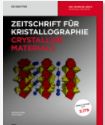 |
Abstract.Solvent-rich dichloromethane solvate of cis-[Ir(bptz)2(CNXyl)2]BF4 (3, bptz is cyclometallated 4-(4-bromophenyl)-2-methylthiazole) is prepared via the reaction of chloro-bridged dimer [Ir(bptz)2(μ-Cl)]2 (1) with 2,6-dimethylphenyl isocyanide (CNXyl, 2) and AgBF4. Single crystal X-ray diffraction on the 3·3¼CH2Cl2 solvate showed the presence of numerous non-covalent interactions, including the C–S···F–B chalogen bonding (ChB), the C–Br···Br–C, C–Cl···Br–C, and C–Cl···S(C)–C halogen bonding (XB), and the C–H···F–B hydrogen bonding (HB). The nature of these short contacts was explored both experimentally by single-crystal X-ray diffraction and theoretically by DFT calculations on the empirical geometries followed by Bader’s topological electron density distribution analysis. The evaluated energies of XBs and ChBs are in range 1.3–2.2 kcal/mol indicating the non-covalent nature of the contacts |